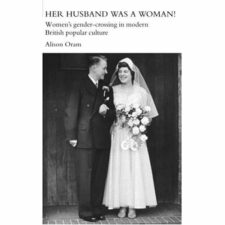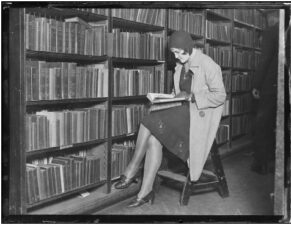At the Herald, I’m told, it wasn’t until World War II that the very first woman was even used as a general reporter. Her name was Neil Bedford (no, you didn’t hear wrong, it was Neil!). She emerged from the women’s section, home to most of the female staff, after so many men left to go to war, including about two dozen Herald men sent off as war correspondents. For similar wartime reasons, a second woman, Molly Luke became the first staff female photographer. Neither stayed very long after the war ended: who knows if they were given the choice to stay or were pushed back into the home by the returning men?
During the ’60s and ’70s, there was a trickle of women doing general news and features, but it wasn’t until the late 1970s that the first woman general news subeditor was appointed. My wonderfully helpful former editor told me that the men’s reluctance to appoint a female was that male sub editors tended to – and I quote – swear quite colorfully – as edition deadlines approached. Hilarious when I think how my team, lots of them women, used to turn the air blue at edition time. And it wouldn’t be until the late 1970s that a woman staff photographer was appointed – and management at the time had reservations even then because of “possible problems” – and I quote again “created by men and women sharing a darkroom”!
Funnily enough, the first woman chief of staff ever appointed to the paper was on deck when I was a rookie. I remember she was the one who sent me home to change clothing when I arrived at work in jeans. “You must dress always ready for the possibility that you could meet the queen,” she said.
Yep that was said, in Sydney, Australia in 1982. This was the same boss who refused to deploy me to the teams covering bushfires not long after saying ‘not appropriate, you’re a young woman’.
Extraordinary as it may seem, the Herald‘s first female Chief Sub-editor was not appointed until the late 1990s and a woman Managing Chief Sub-editor (in charge of all editorial production) was appointed in the 2000s. I won’t even bother going into the continuing rows over women reporters who in some places are still fighting to enter male territory such as football dressing rooms. How do you cover sport if you are not allowed to report the traditional end-of-game press conferences?!
Fast forward a century and the world of news is unrecognizable and I, like so many correspondents of this era have had to revolutionize the way I work – from an often barely daily deadline and workload to a virtual 24/7, stand alone operation. As Vice President of the Foreign Press Association in London, 125 years old this year, I have been intrigued thinking back to the old guard, the newspaper correspondents, pretty much all of them male, who filed once every couple of weeks from the outposts of the empire, including often horrendous theatres of war, to newspapers back home.
No, they did not have Google, sat phones, laptops or the safety that comes from immediacy, and a part of me remains open mouthed at the hardship they encountered. But the other part of me believes honestly that the modern correspondent – and the new demands of a 24 hour news cycle as well as the inhuman amount of information we have to scan and filter every hour – means our professional lives, in some ways, are tougher. For women correspondents, it was the legendary 20th century author and journalist Martha Gellhorn who broke the gender barrier nearly 80 years ago. And today, unfortunately as we saw with Marie Colvin – women are losing their lives alongside the male reporters as they document the wor;d’s conflict zones. Some of the greatest chroniclers of war in our generation are women — among them CNN’s Christiane Amanpour, the BBC’s formidable Kate Adie, Alex Crawford from Sky, Lara Logan from CBS News – and many, many others.
Last year, Logan – who survived a horrendous attack at the hands of what she described as “300 baying men” reporting in Cairo joined 40 other media women in a book which graphically described the special additional risks they’ve faced over the years — and offer their advice on how to prepare for these dangers and best do our jobs.
Their words and experiences provide a powerful reminder that female journalists often offer a different take on war and conflict and unlike many of their male counterparts, remain utterly unimpressed by the whiz bang of the boys toys, knowing only too well that “collateral damage” means people: men, women and so often, little children. Like them, I believe that understanding makes them better journalists.
In all this, there is one fundamental that has changed very little and that is the presence of women at the pointy end of news, the place where the decisions are made – in executive offices, in the publishers’ suite, in the boardrooms of big media companies.
Returning to Dr Louise North’s work published in August 2012 in Australia, we learned that not one woman was entrusted with the editing role in a daily edition of the nation’s 21 metropolitan newspapers although three currently edit weekend editions – as I did before being posted to London.
Similarly, in broadcasting, women’s exclusion from leadership roles is evident although public broadcasters fared slightly better. But even at the Australian Broadcasting Corporation (ABC), equivalent of the BBC, it wasn’t until 2009 that they appointed the first female director of news, Kate Torney. On morning and drive time radio shifts, commercial and public radio is dominated by male voices.
At CEO level, 23 of 24 of the big mainstream media companies in Oz are men – the only woman runs a regional network outside Sydney. Back at my old paper, of the 13 member executive team, 11 are men. The only women at that level are the chief legal counsel and human resources CEO.
And this is in the new world, a nation just 200 years old that prides itself on being open minded, easy going, classless!
Paola Totaro (c) March 2013
Paola Totaro is a journalist who lives in London and worked with the Sydney Morning Herald and The Age in Melbourne, Australia, before coming to the United Kingdom as European Correspondent. She studied at the University of Sydney and the University of New England in Australia, and is presently enrolled in an MA (Culture & Criticism) at the University of the Arts, London. She includes French and Italian amongst her languages, and lists her hometown as Naples, Italy.

